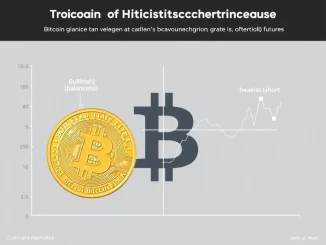
The world of Bitcoin mining is constantly evolving, and a recent development has captured the attention of everyone watching the network. Bitcoin mining difficulty has just reached a significant milestone, hitting a new all-time high. This event is more than just a number change; it signals underlying shifts in the network’s strength and the competitive landscape for Bitcoin miners.
What Does the Latest Difficulty Adjustment Mean?
At approximately 00:01 UTC on May 31, at block height 899,136, the Bitcoin mining difficulty underwent its scheduled adjustment. According to data from CloverPool, this adjustment resulted in a 4.38% increase, pushing the difficulty level to a record 126.98 Tera hashes (T). This figure represents the highest point the network’s difficulty has ever reached.
Understanding mining difficulty is key to grasping the significance of this event. It’s a measure of how hard it is to mine a new Bitcoin block. The Bitcoin protocol is designed to adjust this difficulty every 2,016 blocks (roughly every two weeks) to ensure that, on average, a new block is found approximately every 10 minutes. If blocks are found faster than 10 minutes, difficulty increases; if slower, it decreases.
This recent increase indicates that the collective processing power directed towards mining Bitcoin, known as the Bitcoin hash rate, has grown substantially over the past two weeks. A higher hash rate means more competition to find the next block, so the difficulty must rise to maintain the 10-minute target.
Why is the Bitcoin Hash Rate Increasing?
Several factors can contribute to a rising Bitcoin hash rate:
- New Miners Joining: More individuals or companies setting up mining operations.
- Hardware Upgrades: Existing miners deploying more efficient or powerful mining rigs.
- Favorable Market Conditions: When the price of Bitcoin is high, mining becomes more profitable, incentivizing more participants and investment in equipment.
- Seasonal Factors: Lower energy costs in certain regions during specific times of the year can make mining more attractive.
The surge to a new all-time high in difficulty strongly suggests a robust and growing Bitcoin hash rate, reflecting confidence and increased activity in the mining sector.
How Does This Impact Bitcoin Miners?
For individual Bitcoin miners, a rise in mining difficulty presents both challenges and opportunities:
- Increased Competition: With more hash rate competing for the same block rewards (newly minted Bitcoin plus transaction fees), the probability of any single miner finding a block decreases.
- Potential Impact on Profitability: Unless the price of Bitcoin increases proportionally or miners have exceptionally low energy costs, higher difficulty can squeeze profit margins. Miners need more computational power (and thus potentially more energy) to earn the same amount of Bitcoin.
- Need for Efficiency: This environment favors miners using the latest, most energy-efficient hardware. Older, less efficient machines may become unprofitable and be taken offline.
- Actionable Insight: Miners must constantly evaluate their operational costs, hardware efficiency, and access to cheap energy to remain competitive.
While challenging for less efficient operations, this competitive pressure drives innovation in mining technology and infrastructure.
What Does the Difficulty Adjustment Mean for Network Security?
From the perspective of the Bitcoin network as a whole, a rising Bitcoin hash rate and increasing difficulty adjustment are positive signs. Higher hash rate means the network is more secure. It requires an immense amount of computational power and energy to attempt a 51% attack (controlling the majority of the network’s hash rate to potentially disrupt transactions or double-spend coins). An all-time high hash rate makes such an attack prohibitively expensive and impractical.
Benefits for the network include:
- Enhanced Security: A stronger defense against malicious attacks.
- Increased Robustness: The network becomes more resilient to fluctuations in individual miner participation.
- Confirmation of Health: A high hash rate indicates that miners find it profitable to secure the network, reflecting underlying confidence in Bitcoin’s value and future.
Looking Ahead: The Next Difficulty Adjustment
The difficulty adjustment is a continuous process. The next adjustment is projected to occur in approximately 14 days. Interestingly, the current projection suggests a slight decrease in difficulty, estimated at 0.12%, bringing the level down slightly to 126.83 T. This minor projected decrease could indicate a slight dip in the average hash rate over the next two weeks, though it’s still well within normal fluctuations and doesn’t negate the significance of the recent all-time high.
Projections can change based on how quickly blocks are found in the coming days. Factors like large mining farms going offline temporarily, weather events impacting energy supply, or even just natural variance in block discovery times can influence the final adjustment percentage.
Summary: A Network Growing Stronger
The recent surge in Bitcoin mining difficulty to a new all-time high is a clear indicator of a booming Bitcoin hash rate. While this increases the challenge for individual Bitcoin miners by intensifying competition, it fundamentally strengthens the security and resilience of the Bitcoin network. The continuous difficulty adjustment mechanism ensures Bitcoin remains a robust and decentralized system, adapting automatically to changes in the mining landscape. This milestone highlights the network’s ongoing growth and health, a positive sign for the entire ecosystem.



